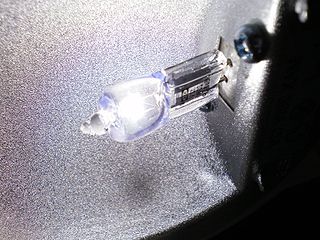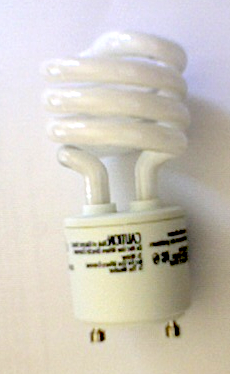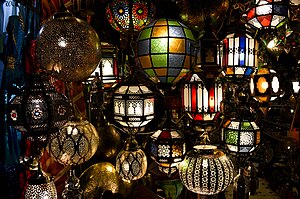
A halogen lamp is an incandescent lamp consisting of a tungsten filament sealed in a compact transparent envelope that is filled with a mixture of an inert gas and a small amount of a halogen, such as iodine or bromine. The combination of the halogen gas and the tungsten filament produces a halogen-cycle chemical reaction, which redeposits evaporated tungsten on the filament, increasing its life and maintaining the clarity of the envelope. This allows the filament to operate at a higher temperature than a standard incandescent lamp of similar power and operating life; this also produces light with higher luminous efficacy and color temperature. The small size of halogen lamps permits their use in compact optical systems for projectors and illumination. The small glass envelope may be enclosed in a much larger outer glass bulb, which has a lower temperature, protects the inner bulb from contamination, and makes the bulb mechanically more similar to a conventional lamp.

Artificial lighting technology began to be developed tens of thousands of years ago and continues to be refined in the present day.

A fluorescent lamp, or fluorescent tube, is a low-pressure mercury-vapor gas-discharge lamp that uses fluorescence to produce visible light. An electric current in the gas excites mercury vapor, which produces short-wave ultraviolet light that then causes a phosphor coating on the inside of the lamp to glow. A fluorescent lamp converts electrical energy into useful light much more efficiently than an incandescent lamp. The typical luminous efficacy of fluorescent lighting systems is 50–100 lumens per watt, several times the efficacy of incandescent bulbs with comparable light output. For comparison, the luminous efficacy of an incandescent bulb may only be 16 lumens per watt.

Lighting or illumination is the deliberate use of light to achieve practical or aesthetic effects. Lighting includes the use of both artificial light sources like lamps and light fixtures, as well as natural illumination by capturing daylight. Daylighting is sometimes used as the main source of light during daytime in buildings. This can save energy in place of using artificial lighting, which represents a major component of energy consumption in buildings. Proper lighting can enhance task performance, improve the appearance of an area, or have positive psychological effects on occupants.

In the signage industry, neon signs are electric signs lighted by long luminous gas-discharge tubes that contain rarefied neon or other gases. They are the most common use for neon lighting, which was first demonstrated in a modern form in December 1910 by Georges Claude at the Paris Motor Show. While they are used worldwide, neon signs were popular in the United States from about the 1920s to 1950s. The installations in Times Square, many originally designed by Douglas Leigh, were famed, and there were nearly 2,000 small shops producing neon signs by 1940. In addition to signage, neon lighting is used frequently by artists and architects, and in plasma display panels and televisions. The signage industry has declined in the past several decades, and cities are now concerned with preserving and restoring their antique neon signs.

A mercury-vapor lamp is a gas-discharge lamp that uses an electric arc through vaporized mercury to produce light. The arc discharge is generally confined to a small fused quartz arc tube mounted within a larger soda lime or borosilicate glass bulb. The outer bulb may be clear or coated with a phosphor; in either case, the outer bulb provides thermal insulation, protection from the ultraviolet radiation the light produces, and a convenient mounting for the fused quartz arc tube.

A compact fluorescent lamp (CFL), also called compact fluorescent light, energy-saving light and compact fluorescent tube, is a fluorescent lamp designed to replace an incandescent light bulb; some types fit into light fixtures designed for incandescent bulbs. The lamps use a tube that is curved or folded to fit into the space of an incandescent bulb, and a compact electronic ballast in the base of the lamp.

Ellipsoidal reflector spot is the name for a type of stage lighting instrument, named for the ellipsoidal reflector used to collect and direct the light through a barrel that contains a lens or lens train. The optics of an ERS instrument are roughly similar to those of a 35 mm slide projector.

An electrical ballast is a device placed in series with a load to limit the amount of current in an electrical circuit.

A parabolic aluminized reflector lamp is a type of electric lamp that is widely used in commercial, residential, and transportation illumination. It produces a highly directional beam. Usage includes theatrical lighting, locomotive headlamps, aircraft landing lights, and residential and commercial recessed lights.

A multifaceted reflector light bulb is a reflector housing format for halogen as well as some LED and fluorescent lamps. MR lamps were originally designed for use in slide projectors, but see use in residential lighting and retail lighting as well. They are suited to applications that require directional lighting such as track lighting, recessed ceiling lights, desk lamps, pendant fixtures, landscape lighting, retail display lighting, and bicycle headlights. MR lamps are designated by symbols such as MR16 where the diameter is represented by numerals indicating units of eighths of an inch. Common sizes for general lighting are MR16 and MR11, with MR20 and MR8 used in specialty applications. Many run on low voltage rather than mains voltage alternating current so require a power supply.

A grow light is an electric light to help plants grow. Grow lights either attempt to provide a light spectrum similar to that of the sun, or to provide a spectrum that is more tailored to the needs of the plants being cultivated. Outdoor conditions are mimicked with varying colour temperatures and spectral outputs from the grow light, as well as varying the intensity of the lamps. Depending on the type of plant being cultivated, the stage of cultivation, and the photoperiod required by the plants, specific ranges of spectrum, luminous efficacy and color temperature are desirable for use with specific plants and time periods.

A bipin or bi-pin is a type of lamp fitting. They are included in the IEC standard "IEC 60061 Lamp caps and holders together with gauges for the control of interchangeability and safety". They are used on many small incandescent light bulbs, and for starters on some types of fluorescent lights.

An LED lamp or LED light is an electric light that produces light using light-emitting diodes (LEDs). LED lamps are significantly more energy-efficient than equivalent incandescent lamps and fluorescent lamps. The most efficient commercially available LED lamps have efficiencies exceeding 200 lumens per watt (lm/W) and convert more than half the input power into light. Commercial LED lamps have a lifespan several times longer than both incandescent and fluorescent lamps.
Aquarium lighting describes any type of artificial lighting that is used to illuminate an aquarium. Some types of aquaria such as reef aquariums and planted aquariums require specialized high intensity lighting to support photosynthetic life within the tank.
T5 retrofit conversion is a means of converting light fittings designed to use T8 format lamps, so that they can use more energy-efficient T5 lamps. This is done by electronically converting the luminaires to high frequency operation.
United States Lighting Energy Policy is moving towards increased efficiency in order to lower greenhouse gas emissions and energy use. Lighting efficiency improvements in the United States can be seen through different standards and acts. The Energy Independence and Security Act of 2007 laid out changes in lighting legislation for the United States. This set up performance standards and the phase-out of incandescent light bulbs in order to require the use of more efficient fluorescent lighting. EISA 2007 is an effort to increase lighting efficiency by 25-30%. Opposition to EISA 2007 is demonstrated by the Better Use of Light Bulbs Act and the Light Bulb Freedom of Choice Act. The efforts to increase lighting efficiency are also demonstrated by the Energy Star program and the increase efficiency goals by 2011 and 2013. A ban on the manufacture and sale of most general purpose incandescent bulbs in the U.S. took effect on August 1, 2023.
A lightbulb socket, lightbulb holder,light socket, lamp socket or lamp holder is a device which mechanically supports and provides electrical connections for a compatible electric lamp base. Sockets allow lamps to be safely and conveniently replaced (re-lamping). There are many different standards for lampholders, including early de facto standards and later standards created by various standards bodies. Many of the later standards conform to a general coding system in which a socket type is designated by a letter or abbreviation followed by a number.

A GU24 lamp fitting is a bi-pin connector for compact fluorescent lamps (CFL) or LED lamps that uses a bayonet mount–like twist-lock bi-pin connector instead of the Edison screw fitting used on many CFLs, LED lamps and incandescent light bulbs. The design was initiated by the U.S. EPA and the Lighting Research Center in 2004, in order to facilitate the deployment of compact fluorescent light bulbs with replaceable ballasts.

LED tube is a type of LED lamp used in fluorescent tube luminaires with G5 and G13 bases to replace traditional fluorescent tubes. As compared to fluorescent tubes, the most important advantages of LED tubes are energy efficiency and long service life. LED tubes are sometimes also referred to as ‘LED fluorescent tubes’.




















